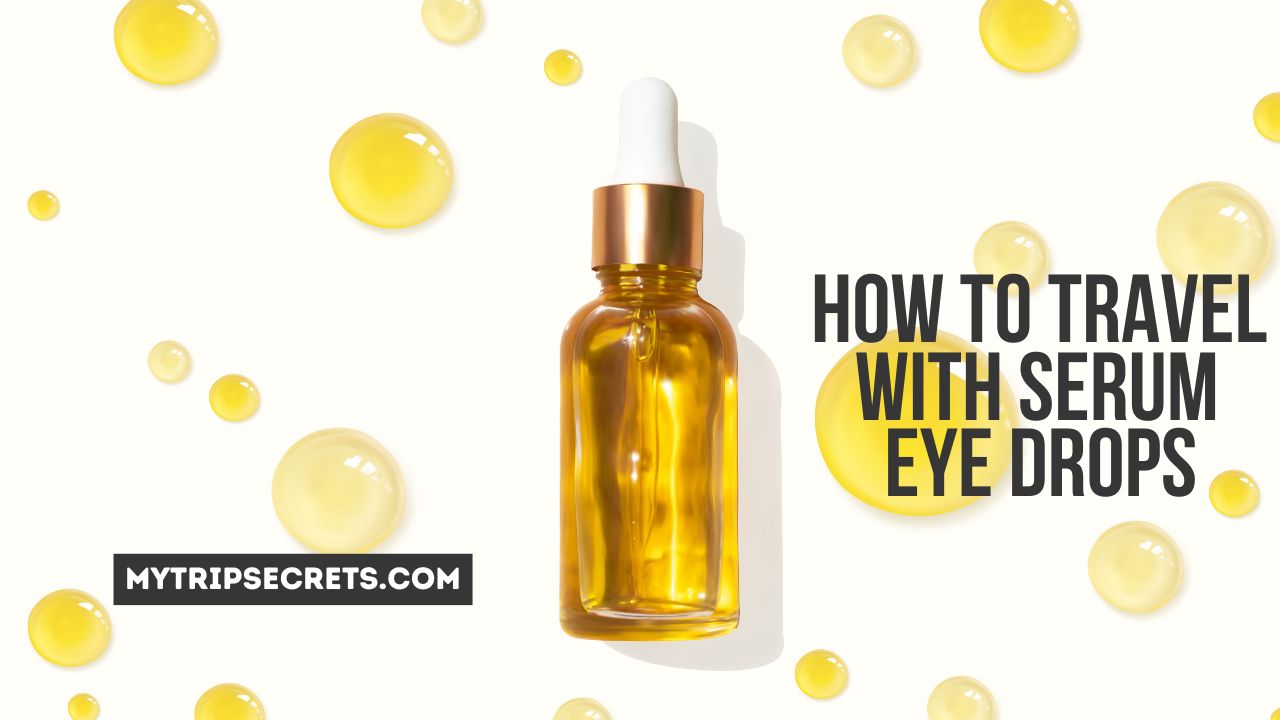Traveling while reliant on specialty serum eye drops poses immense challenges beyond contact solutions. Serum eye drops specifically treat diagnosed conditions with complex formulations requiring meticulous care and handling to retain effectiveness when transporting them. Safely getting these delicate serums through airports as carry-ons or stashed inside checked bags demands next-level planning to maintain sterility, potency and prevent messy leaks.
If visions of relaxing beach vacations include fruited cocktails, the serum eye drop reality may instead mean scanning hotel fridges for storage space. Excursions can feel dictated by humidity threatening unrefrigerated serum eye drops or probing airport staff questions on your many bottles. Travel logistics alongside ophthalmic conditions dependent on serum eye drops can quickly dampen wandering spirits.
Contents
How to Travel with Serum Eye Drops
The first step is selecting an optimal eye drop bottle for ease of packing and minimal mess. Here are a few aspects to consider:
Material
Plastic eye drop bottles are typically more durable and leak-resistant compared to thin glass bottles. Hard plastic bottles also better withstand being knocked around in your luggage. Softer, squeezable plastic bottles make it easier to administer drops one-handed, but opt for a sturdier version less prone to cracking open in a bag.
Size
The standard 5mL eye drop bottle is a good balance of portability and adequate capacity for most trips under 2 weeks. For longer journeys or very frequent application, 10mL bottles provide more supply. Anything larger gets unruly to carry. Sterile, unopened back-up bottles can supplement if needed.
Dispenser Tip
A firmly-sealing bottle is essential to avoid spills. Flip-top caps with eye dropper dispensers give more control than lift-top bottles. Nozzles that snap securely shut post-use further reduce risk of leaks.
Extra Features
Some travel-friendly bottles incorporate helpful extras like dosage markings to track use or loops for attaching lanyards for easily grabbing from a purse or gear bag. While convenient, more projecting parts could break if not properly protected.
Table Comparing Eye Drop Bottle Options
| Bottle Type | Pros | Cons | Good For |
|---|---|---|---|
| Squeezable plastic | – Easily dispenses drops one-handed<br>- Low cost | – More prone to damage and leaks<br>- Flimsy with repeated use | Short trips (under 1 week) |
| Rigid plastic | – Durable and leak-resistant<br>- Often has integrated dispenser | – Difficult to squeeze<br>- Could shatter if crushed | All travel lengths |
| Glass | – Most packaging options<br>- Preferred by some for eye comfort | – Heavy<br>- Risk of breakage and leakage | Short, protected trips (under 5 days) |
| Multi-dose units | – No need to carry full bottles<br>- Pre-measured doses | – Wasteful<br>- Costly compared to bottles | Occasional or emergency use |
TSA Rules for Packing Liquids
When preparing eye drops and any liquids for airplane travel, be clear on the current TSA regulations to avoid confiscation at airport security:
- All liquids, gels, aerosols must be in containers 3.4 ounces (100ml) or smaller
- Bottles should be grouped together in a single quart-size, clear, sealable plastic bag
- Only one plastic bag of liquids is allowed per passenger in a carry on
- Checked luggage can contain larger volumes of liquids
- Exceptions cover any medically-necessary liquids, which eye drops qualify as for documented ophthalmic conditions
If carrying prescription serum eye drops or those for a diagnosed chronic eye issue, proactively alert TSA agents when you reach the scanner conveyor belt. Present any paperwork proving your condition and products if asked. With this verification, there is no limit on the quantity of eye drops permitted on board, even above the 3.4 ounce limit.
Without a noted medical necessity, stick to under 3.4 ounces per bottle and group with any other liquids in your clear TSA bag. Recap each bottle containing liquids, gels or sprays tightly to prevent mess leaks in transit through security screening equipment.
Protecting Eye Drops from Damage or Contamination
Once you have TSA-approved bottles and packing configurations in place, it’s vital to shelter serum eye drops from harm en route:
Cushion Drops Against Shock and Impact
Serums incorporate delicate proteins, enzymes, antioxidants and other components degraded by intense shaking. Shield bottles with extra clothing layers in checked bags and surround snugly with socks or soft pouches in carry ons. Choose spots less likely to be compressed like the very center of your luggage.
Avoid stowing eye drops in exterior pockets on bags vulnerable to bumps and drops. Never check delicate glass bottles at risk of fracture and leaking in cargo holds.
Maintain Cool Environment Without Freezing
Most serums require refrigerator temperatures between 35-46°F to retain purity and potency. Specialized drop cooling packs are available, or improvise with sandwich bags of ice wrapped in paper towels. Position ice packs touching bottom or sides, not directly against bottles where freezing could damage contents.
In hot climates or seasons, insulate bags to block sun exposure. Take bottles out of bags during airport waits so they don’t overheat in capsulated spaces without air circulation.
Keep Bottles Upright
Always store eye drops upright and never on their sides. Tilting can wet nozzles and tops, inviting contamination and awkward, messy dispensing upon use. Upright positioning also keeps flip cap openings facing away from other items pressing on lids and potentially releasing precious drops.
Stand bottles in zipper pouches tall enough to keep them vertical or stash in water bottle holders in backpack side pockets. When seated on flights, do not place bags harboring drops on floor areas prone to spilling.
Restrict Access by Other Items
Ensure serum eye drops don’t come into contact with liquids, gels, lotions or soaps that could seep into sterile nozzles or accidently mix into the bottle. Keep drops in their own sealed plastic bags or protective hard cases. Never overstuff suitcases or bags causing contents to press forcefully on properly-positioned drops.
Maintaining Handling Sterility Through Travel
Air travel exposes belongings to scores of germs via security bins, tray tables, armrests and lavatory door handles. Guard serum purity with good hand hygiene.
Wash Hands Frequently
Use soap and water before administering eye drops whenever possible. When only sanitizer is available, ensure hands are completely dry before touching sterile bottles and avoid dropper tip contact.
Don’t Reuse Single-Dose Vials
Carry only properly stored, multi-dose bottles. Never refill or top off any sterile, single-use containers compromised once initially opened.
Keep Nozzles and Tips Clean
Always recap after use without contacting the drop dispenser. If tip contacts hands or surfaces, clean thoroughly with fresh water on a sterile pad before recapping.
Avoid Community Eye Medications
Never share eye drops with others who may transfer germs. Use only your own containers handled only by you.
Be diligent following such eye drop safety and hygiene protocols throughout all travels to preserve efficacy and purity of your vulnerable, heat-sensitive serums.
Application While in Motion
Applying eye drops smoothly amid turbulent planes, trains and automobiles takes some strategic preparation:
Position Yourself Strategically
Sit upright in a window seat with room to tilt your head back slightly and angle the bottle above the eye. Avoid middle seats without space to properly tip bottles or aisle spots in the path of beverage carts.
Bathrooms offer cramped counters for placing products temporarily and better drop administration angles in mirrors. Choose larger handicap stalls for most room to maneuver.
Time Drops With Minimum Motion
Wait for smoother points in your journey when vehicles or vessels feel most stable and steady to prevent misses or splashing. Apply drops during level cruising phases on aircraft, between subway stops or when parked in a car or RV.
Stabilize Bottles Over Eyes
Rest wrists or hands on stable objects like armrests, mirrors or ledges so bottles hover steadily over eyes without wavering. Alternatively, brace administering elbows on walls or sinks to create a sturdy triangular base.
Tilt Head Back Under Lids
Tilting opens eyelid space and minimizes blinking so eyedrop bottles or single-doses pods can dispense directly onto the surface of the eye. Practice varying degrees of head tilt in chairs, beds and floor positions to find optimal angles.
With smart preparation, protection and administration techniques, travelers can venture anywhere their journeys take them without compromising the integrity of the sensitive serums keeping their eyes healthy.
Frequently Asked Questions
How long can serum eye drops last unrefrigerated?
Most serums maintain potency for 7-10 days unrefrigerated and up to 6 months refrigerated once opened. Unopened bottles can endure 12-24 months refrigerated. Travel with enough for your journey timeline plus an extra week as a precaution.
What if my eye drops freeze in cargo?
Inform airline personnel immediately on landing if you suspect freezing. Never use drops not guaranteed maintained between 35°-46°F. Safely discard and replace damaged products.
Can I take eye drops in my pocket through TSA?
Yes, with medical verification of need. Without documented medical necessity, stick to under 3.4 ounce bottles in clear plastic bags.
What if I lose my eye drops or run out?
Carry prescription details to get refills from local pharmacies. For OTC drops, buy replacements wherever you are and continue the same sterile handling protocols. Schedule urgent telehealth appointments if specific serums are irreplaceable.
Can I reuse empty eye drop bottles?
Never reuse old bottles which increase infection risks. Always start trips with fresh, unopened bottles with intact seals.
What if my drops spill inside my luggage?
Contain leaks with plastic bags or absorptive gear. Deep clean soaked items after trips and monitor eyes for any infection signs suggesting contaminated fluid contacted surfaces subsequently touching eyes.
Conclusion
Traveling safely with specialized serums means treating them as valuably as any other necessity you transport. Protect eye health by proactively planning for temperature, sterility, leakage and application hurdles serum drops face once out of their steady home medicine cabinets. Invest in quality storage and handling accessories giving control over unpredictable journeys.
Consistently implement science-backed protocols like refrigerating, triple bagging, never touching nozzles and washing hands thoroughly before use. Seek expert guidance configuring optimal travel kits suited to your specific ophthalmic conditions and serum formulations.
While inconvenient at times, such diligent care pays off in maintaining potency of these fragile eyedrops formulated precisely to address your needs. Have a wonderful trip without skipping a dose or worrying about delicate vials shattering, freezing or leaking into clothing and accessories sharing tight quarters during exciting travels!
Resources
TSA Guidelines on Traveling with Disabilities and Medical Conditions
CDC Infection Prevention and Control Recommendations for Eye Drop Use
Review of Ophthalmic Preparations and Considerations for Travel

